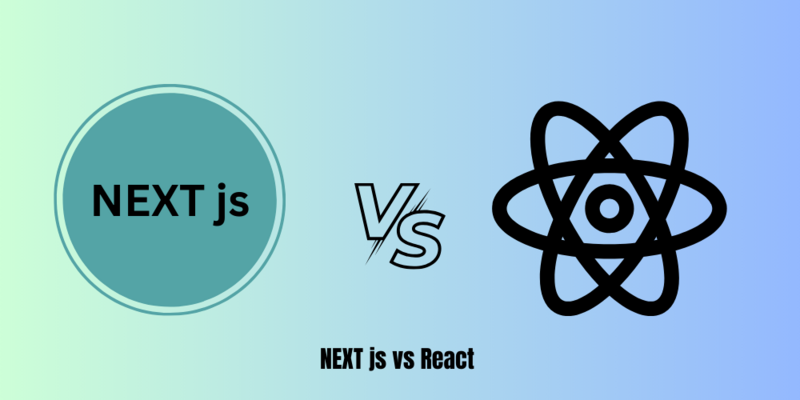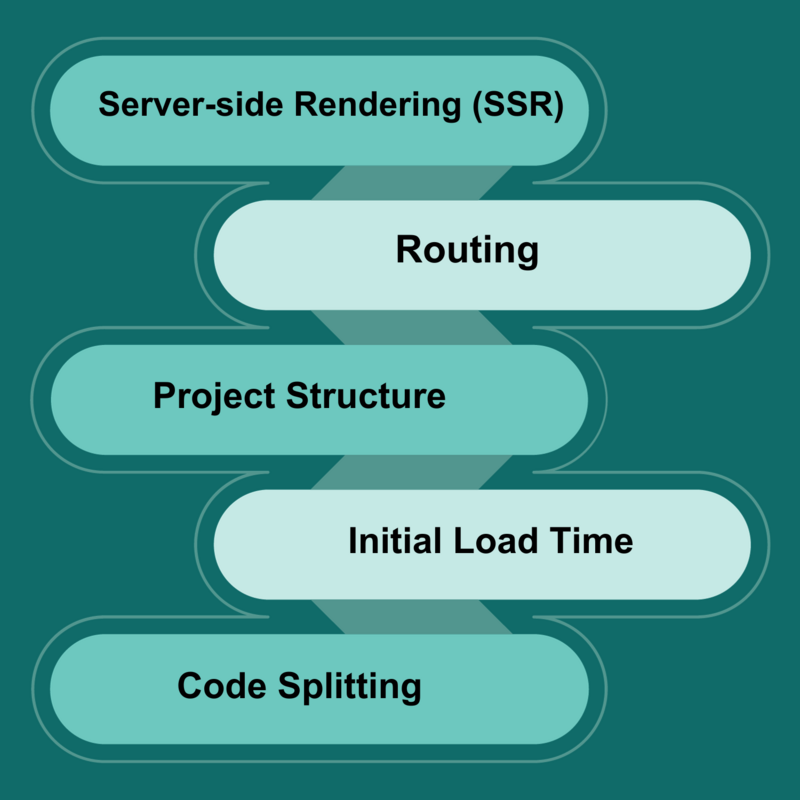In the ever-evolving landscape of web development, choosing the proper JavaScript framework is a pivotal decision that can significantly impact the success of your projects. Two leading contenders in this arena are React and Next.js. In this comprehensive guide, "React vs. Next.js: Unveiling the Best JavaScript Framework for Your Development Goals," we'll unravel the strengths, nuances, and best use cases of these two powerful frameworks.
 JavaScript frameworks are critical in web development, enabling developers to efficiently create dynamic, feature-rich web applications. With React and Next.js being at the forefront of this domain, it's essential to have a clear understanding of their features, benefits, and when to use them to ensure that your development goals are met and exceeded.
JavaScript frameworks are critical in web development, enabling developers to efficiently create dynamic, feature-rich web applications. With React and Next.js being at the forefront of this domain, it's essential to have a clear understanding of their features, benefits, and when to use them to ensure that your development goals are met and exceeded.
This guide aims to provide you with a wealth of knowledge, comparisons, real-world examples, and expert insights, empowering you to make informed decisions when selecting the ideal framework for your specific projects.
Throughout this exploration, we'll delve into what React and Next.js are, examining their core principles and features. We'll conduct a head-to-head comparison, dissecting key differences and addressing common questions, such as whether to use Create React App or Next.js. You'll gain a deeper understanding of their advantages, and more importantly, we'll explore the scenarios where one framework shines over the other.
But the journey doesn't stop there. We'll showcase real-world success stories and case studies for React and Next.js so you can see how top-notch development teams harness these frameworks to create powerful, innovative applications.
Understanding React and Next.js
A deep understanding of the available options is crucial when choosing the proper JavaScript framework for your web development projects. In this section of our guide, "React vs Next.js: Unveiling the Best JavaScript Framework for Your Development Goals," we will lay the foundation by exploring the fundamental principles and characteristics of React and Next.js.
What Is React?
React, developed and maintained by Facebook, is a widely popular JavaScript library for building user interfaces. Its component-based architecture sets React apart, which allows developers to create reusable UI elements, making it ideal for building complex and interactive web applications.
Key features and concepts of React include:
- Virtual DOM: React employs a virtual representation of the Document Object Model (DOM) to optimize rendering performance. This means that when data changes, React updates only the necessary parts of the actual DOM, resulting in faster and more efficient updates.
- Component-Based: React applications are built by creating reusable components, which can be composed to make the entire user interface. This modular approach simplifies code maintenance and promotes code reusability.
- One-Way Data Binding: React enforces a unidirectional data flow, ensuring that data changes are predictable and easy to trace, which is essential for large-scale applications.
- Declarative Syntax: Developers describe what the UI should look like at any given point, and React updates the UI when the underlying data changes.
- Large Ecosystem: React is supported by a vast ecosystem of libraries, tools, and community-contributed components, making it a versatile choice for various applications.
What Is Next.js?

Next.js is a robust framework built on React, designed to simplify server-rendered React applications and streamline the development process. It offers powerful features for building modern web applications with server-side rendering, routing, and more.
Key features and advantages of Next.js include:
- Server-Side Rendering (SSR): Next.js excels in rendering web pages on the server side, which can significantly improve performance, SEO, and user experience. It pre-renders pages and delivers a fully rendered HTML page to the client, reducing initial load times.
- Automatic Code Splitting: Next.js automatically splits JavaScript bundles for different pages, optimizing load times by serving only the necessary code to the client.
- Client-Side Navigation: It provides a seamless client-side navigation experience, similar to what single-page applications offer, enhancing the user experience without compromising on SEO and initial load times.
- Built-in Routing: Next.js includes a powerful routing system that simplifies navigation and supports dynamic routes and parameters.
- Static Site Generation (SSG): Next.js allows for generating static HTML files at build time, making it possible to serve content faster and cache it on CDNs.
- Rich Plugin Ecosystem: Like React, Next.js has a growing ecosystem of plugins and extensions, making integrating various technologies and tools accessible.
Head-to-Head Comparison
We must delve deep into a head-to-head comparison between React and Next.js to identify the best JavaScript framework for your development goals. This section of our guide, "React vs Next.js: Unveiling the Best JavaScript Framework for Your Development Goals," explores the key differences and nuances that set these two powerful technologies apart.
Next.js vs React: Key Differences
The battle between Next.js and React is a common point of contention for developers. Understanding the fundamental distinctions between these two is crucial for making an informed choice. Here are some key differences to consider:
 Server-side Rendering (SSR): Next.js is renowned for its built-in server-side rendering support, significantly enhancing SEO and initial page load times. On the other hand, React primarily focuses on client-side rendering, which can be less SEO-friendly but offers different advantages.
Server-side Rendering (SSR): Next.js is renowned for its built-in server-side rendering support, significantly enhancing SEO and initial page load times. On the other hand, React primarily focuses on client-side rendering, which can be less SEO-friendly but offers different advantages.
Routing: Next.js provides an integrated routing system that simplifies client-side navigation. While it supports client-side routing, React often relies on third-party libraries like React Router for advanced routing features.
Project Structure:Next.js comes with a predefined project structure that encourages convention over configuration, making it easier to get started with server-side rendering and other features. Being a library, React allows more flexibility in project structure but may require more configuration for certain features.
Initial Load Time: Next.js optimizes initial load times by pre-rendering pages on the server, while React apps initially load a minimal HTML file and then rely on JavaScript to render the page. This can make Next.js a better choice for content-heavy websites or applications with a strong SEO focus.
Code Splitting: React and Next.js support code splitting, but Next.js simplifies the process with automatic code splitting, resulting in smaller initial bundle sizes. React applications may require more manual configuration for code splitting.
Create React App vs Next.js
When it comes to kickstarting your project, you may wonder about the differences between Create React App (CRA) and Next.js:
CRA is a tool for quickly setting up a new React project with sensible defaults and a predefined project structure. It's an excellent choice for developers looking to start with React without dealing with complex configurations.
Next.js, as mentioned earlier, is a framework built on top of React. It simplifies server-side rendering, routing, and other aspects of React development. If you need features like server-side rendering and optimized routing right from the start, Next.js is the way to go.
React Router vs Next.js
When it comes to routing in your web applications, you might consider React Router and Next.js:
React Router is a popular library for client-side routing in React applications. It's a solid choice if you're building a single-page application and require complex routing features.
Next.js includes its routing system, combining client-side navigation with server-side rendering benefits. If you're looking for SEO-friendly routing and seamless page transitions, Next.js's routing is a strong contender.
The Fundamental Difference Between React and Next.js
At the core, the fundamental difference between React and Next.js lies in their intended use cases:
React is a JavaScript library for building user interfaces. It's highly flexible and can create single-page and server-side-rendered applications. Its primary focus is on the presentation layer of your application.
Next.js is a framework that extends React to include server-side rendering, routing, and other helpful features. It's designed for building complete web applications, especially those that benefit from SEO improvements and optimized initial load times.
Choosing the Right Framework
In the world of web development, selecting the proper JavaScript framework is a critical decision that can significantly impact the success of your projects. With our guide, "React vs Next.js: Unveiling the Best JavaScript Framework for Your Development Goals," we aim to assist you in making an informed choice based on your specific project requirements. In this section, we'll explore when to use React and when to opt for Next.js to ensure that you're aligning your development goals with the most suitable framework.
When to Use React
React is a versatile and powerful JavaScript library, and there are situations where it shines:
- Single-Page Applications (SPAs): If your project revolves around creating a single-page application where most of the user interface is rendered on the client side, React is an excellent choice. Its component-based architecture and virtual DOM make it perfect for building interactive SPAs.
- Large Ecosystem and Community: React has a vast and active community, which means you'll find a wealth of libraries, components, and resources to support your project.
- Customization: React offers high flexibility and can be customized to meet your needs. If you have unique requirements, React allows you to tailor your application precisely.
- Client-Side Rendering (CSR): For projects that primarily require client-side rendering and can benefit from the simplicity of CSR, React provides an ideal solution.
When to Use Next.js
Next.js comes into its own in specific scenarios:
- Server-Side Rendering (SSR): If your project requires server-side rendering to improve SEO, initial page load times, and overall user experience, Next.js is the framework of choice. It streamlines the server's rendering process, making it ideal for content-heavy websites and applications.
- Optimized Routing: If you're building an application where routing is a significant consideration, Next.js's integrated routing system simplifies client-side navigation while supporting server-side rendering, giving you the best of both worlds.
- Preconfigured Project Structure: Next.js provides a predefined project structure, promoting convention over configuration. This makes it an excellent choice for developers who want to start quickly without diving into complex project setups.
- SEO-Focused Projects: For projects that prioritize search engine optimization and aim to rank well in search results, Next.js's server-side rendering capabilities give you a significant advantage.
- Performance-Centric Applications: Next.js is tailored for applications where performance is crucial. Whether optimizing initial load times or reducing the size of JavaScript bundles, Next.js excels in this area.
Real-World Applications
To gain a more comprehensive understanding of when to use React and Next.js, let's look at real-world applications where these frameworks have been successfully employed.
React Success Stories
- Facebook: React was developed by Facebook, and it's been extensively used for various features within the platform. Its component-based architecture allows for modular development and seamless user experiences.
- Instagram: Instagram, another social media giant, benefits from React's ability to handle complex, interactive features and high user engagement.
- WhatsApp: WhatsApp's web client relies on React to provide a responsive and dynamic user interface.
Next.js Success Stories
- Netflix: Netflix uses Next.js to improve its performance, SEO, and user experience. The server-side rendering capabilities of Next.js help deliver content quickly to users.
- Twitch: Twitch, a live streaming platform, employs Next.js for its web application to ensure smooth, server-rendered experiences for its vast user base.
- Uber: Uber's web platform utilizes Next.js to offer a fast, SEO-friendly, responsive experience for drivers and riders.
In these real-world applications, React and Next.js have been leveraged to achieve specific goals and meet the unique requirements of each project.
Conclusion: Making Informed Decisions
As we draw the curtain on our comprehensive guide, "React vs Next.js: Unveiling the Best JavaScript Framework for Your Development Goals," it's time to distill the wealth of information we've explored and empower you to make well-informed decisions for your development projects.
Selecting the proper JavaScript framework is a pivotal choice, and the decision hinges on various factors, including the nature of your project, your development team's expertise, performance requirements, and SEO goals. React and Next.js each have their strengths, and understanding these strengths is essential to align your framework choice with your specific development goals.
React is a versatile library that excels in creating dynamic user interfaces for single-page applications. Its component-based architecture, large community, and high degree of customization make it an excellent choice for various projects. React can be your trusted companion if you're focusing on building interactive web applications with a robust client-side rendering approach.
Next.js, on the other hand, is a full-fledged framework built on top of React. It's designed to simplify server-side rendering, routing, and other aspects of web development. When your project demands server-side rendering for improved SEO, faster initial load times, and optimized routing, Next.js emerges as the frontrunner. Its opinionated project structure and preconfigured settings make it a natural choice for SEO-focused applications and content-rich websites.
In real-world applications, giants like Facebook, Instagram, WhatsApp, Netflix, Twitch, and Uber leverage React and Next.js to meet their specific development goals. These success stories exemplify the versatility and capabilities of these frameworks, showcasing their effectiveness across different domains.
So, as you embark on your journey to choose the best JavaScript framework for your development goals, here are some key takeaways:
- Assess Your Project Requirements: Begin by thoroughly understanding your project's needs. Is SEO a priority? Are you building a content-heavy website? Do you require server-side rendering or prefer a client-side approach? These questions will guide your framework selection.
- Consider Your Team's Expertise: Evaluate your development team's familiarity with React and Next.js. A framework your team is comfortable with can lead to more efficient development and faster project delivery.
- Performance Matters: If performance is a crucial concern for your project, consider whether the framework's features, like server-side rendering and automatic code splitting, align with your performance goals.
- SEO Focus: If search engine optimization is at the forefront of your project, the server-side rendering capabilities of Next.js provide a significant advantage in improving your website's discoverability and ranking.
- Flexibility vs. Convention: React offers high flexibility, allowing you to customize your project structure and configurations. Next.js follows a more opinionated approach with a predefined project structure.
In conclusion, choosing React and Next.js is not a one-size-fits-all decision. Your development goals and project requirements will dictate the best framework for your needs. By understanding each framework's strengths and use cases, you're well-equipped to make an informed decision that aligns with your specific goals. Whether you're embarking on a single-page application or building a content-rich website with SEO in mind, the proper framework awaits your selection.
Newsletter to recieve
our latest company updates
Comment